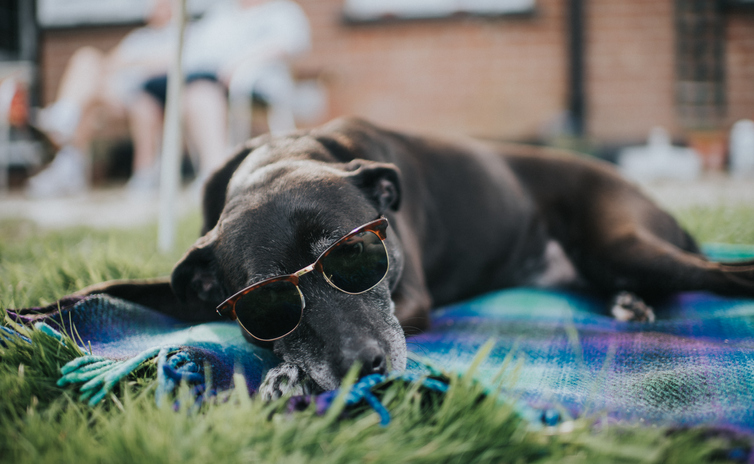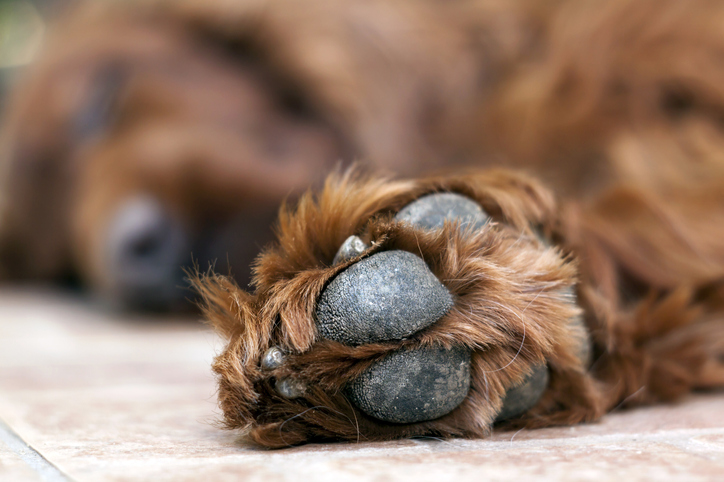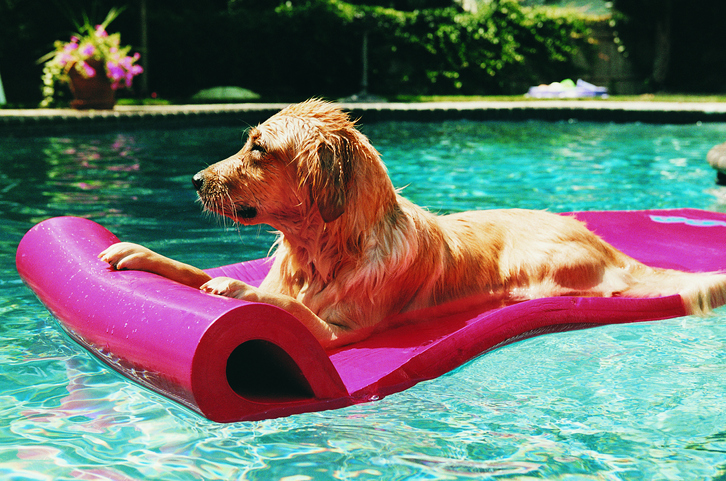Do dogs sweat? How hot dogs keep cool
Walking around in the heat feeling water across your body and wondering do dogs sweat too? You're not alone

So it's really hot outside and you feel as if you've just jumped into a swimming pool. Water is pouring off your body and you just want to take the temperature down a notch because the weather is just too uncomfortable. Then you look over at your dog who looks relatively dry despite being covered by a mass of fur. What gives? Is the dog not sweating too?
The answer, quite simply, is yes. And no. Ok, so not quite so simple then. Thing is, a dog doesn't sweat in the same way that we do. If they had sweat glands distributed across their bodies like humans, then any fluid expelled from the skin's pores would not evaporate when it made contact with the air. Instead, it would become trapped in the fur and your pet would remain a hot dog.
This is why you don't find canines dripping in sweat and yet they must be keeping cool somehow otherwise they would overheat. Luckily, we're here to clear up this little conundrum and show you how hot dogs keep cool without sweat pouring from their body's pores. It's also worth knowing how to avoid dog heatstroke and to get to know the 9 dog breeds most at risk in hot weather.
Do dogs have sweat glands?
Like humans, dogs have two types of sweat glands: eccrine and apocrine. In the human body, eccrine glands are found everywhere and they open on to the surface of our skin. Apocrine glands, on the other hand, are found in our armpits and our genital regions and they open into the hair follicle. Any pong in these areas is due to bacteria breaking the dried sweat down..
Dogs switch things around to some degree. They don't have anywhere near as many eccrine glands as we do but they still work in a similar way to ours', secreting water through their pores. Dogs also have loads of apocrine sweat glands – in fact, they are all over a dog's body. Yet they don't actually work to cool a canine (and they don't cause pongs either so you won't need the best dog shampoo just yet).
Instead these glands are producing chemical signals called pheromones used for communication with other dogs. But that still begs the question of where the eccrine glands are doing their work.

Do dogs sweat through their paws?
Absolutely! Got it in one! Have a think about it. There are hairs all over a dog's body but there are very few to be found on the paw pads. So, yes, dogs sweat through their paws.
Get the best advice, tips and top tech for your beloved Pets
Nature has found a way of ensuring that the paws are packed with eccrine glands – which are also known as merocrine. Since there are so few hairs, they can secrete water, safe in the knowledge that the sweat won't become trapped by masses of fur.
This will allow water to simply form on the surface, from where it can evaporate and cool. But that's not all. A dog's nose will also sweat because, again, there are very few hairs there. What all of this means, though, is that our canine companions are finding other ways to control their body temperature.
How can you tell if a dog is sweating?
In general, there are two main telltale signs. First, watch what happens when a dog is walking on a dry surface on a hot day. It's likely you will see a trail of little wet paw prints being left behind which is evidence of dog sweat.
Second, pay attention to a dog's face. A sweating pooch's nose will become wetter than usual, either because of warm weather or strenuous exercise.
But don't rely on sweat to tell you if a dog is hot. The biggest giveaway that a pooch is looking to cool down is panting which, alongside the expansion of blood vessels in their face and ears, is a dog's main way of regulating their temperature.
By opening their mouth and sticking their tongue out, a canine is allowing moisture to evaporate. At the same time, cooler external air is being exchanged with the hot air of their lungs. But it's not the most efficient way for an animal to regulate body temperature.
To that end, watch out for excessive panting. That's a sure sign that your dog is far from comfortable, especially if you're spotting drool and the tongue and gums are becoming more red. At this stage, you're going to have to take some action and try and cool your dog down.

How to keep a dog cool
It's important to know how to cool a dog because overheating is dangerous. In general, dogs can keep cool in much the same way as we can, so if it's a hot day try not to expose a dog to too much sun. Ensure there is plenty of shade and maybe consider the best cooling mat for dogs – these are very effective in absorbing heat from your pet.
At the same time, keep a dog hydrated with a good supply of cool water and don't engage in strenuous exercise when the rays are at their strongest: wait until later in the day or encourage play early in the morning.
In other words, care for a dog in the same way as you'd care for yourself. If you're having a frozen treat, ensure your furbaby has one too. If you're going for a paddle, then think about the best swimming pool for dogs. And, of course, if you would feel uncomfortable sitting in a car on a hot day, then think how a hairy animal would fare – certainly never leave a dog unattended in a warm vehicle.
But what if you suspect a dog is suffering heatstroke. In this case, seek immediate help from a vet on how to avoid dog heatstroke. One thing's for sure, don't rely on a dog's sweat glands to keep them sufficiently cool. Yes, dogs do sweat but nowhere near enough to be effective.
You might also want to read: How much water should my dog drink and Why do dogs pant? Or, learn how to cool down a dog

David Crookes has been a journalist for almost 30 years and he has written for a host of magazines, newspapers, websites and books including the World of Animals Annual, BBC Earth, Live Science, The Independent and Tom’s Guide.
Born in England, he lives with two cats but he’s also keenly interested in the differences between the huge number of dog breeds – in fact, you can read many of his breed guides that he’s written in collaboration with vets here on PetsRadar.
With a lifelong passion for technology, too, he’s always on the lookout for useful devices that will allow people to keep their pets happier and healthier, and provide them more time to spend together.
David has a degree from Durham University, as well as postgraduate diploma in journalism from the University of Central Lancashire.
